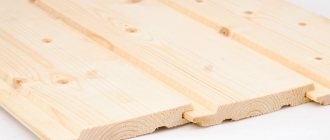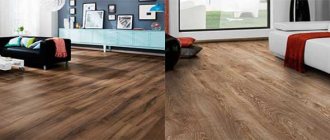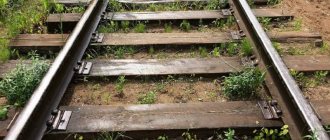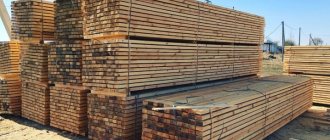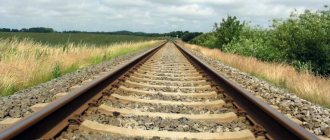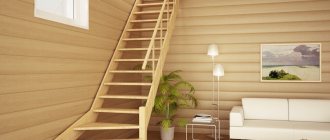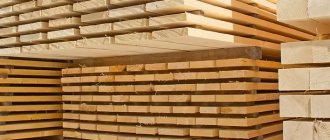The cross-sectional shape and dimensions of railway sleepers are standardized and must strictly comply with the technical regulations of GOST 78-2004 for each specific type of sleeper product. The purpose of railway tracks and their capacity is the main criterion for classifying sleepers and determining their overall parameters and other technical characteristics.
Standard types of sleepers
The standard provides for the classification of wooden railway sleepers depending on the grade of the tracks and the method of processing the timber. All railways are divided into five classes, which determine their purpose, cargo flow and maximum permissible speed.
- 1st and 2nd classes - railway lines that can withstand train speeds of more than 100 km/h without significant deformation, with a total annual freight load of over 5 million ton-kilometers.
- 3rd and 4th – industrial and other access roads with high daily traffic intensity during sorting of trains at stations and at unloading and loading dead ends.
- 5th – lightly loaded railway tracks for shunting and other export purposes.
The sleeper grid must correspond to the class of the railways. There are four types of railway sleepers for this purpose.
- I – main trunk railway lines of 1st and 2nd classes.
- II – access and station sections of tracks of the 3rd and 4th classes.
- III – transport interchanges at industrial enterprises and at unloaded station dead-ends.
The processing method or cross-sectional shape of wooden sleepers is also classified according to the standard.
- Edged - profile shape in the form of a regular square.
- Semi-edged - one of the corners of the rectangular section is missing.
- Untrimmed – opposite edges have been removed. This is commonly found among used refurbished track sleeper components.
Each type and subtype of wooden rail sleepers has its own standardized overall dimensions and profile parameters to ensure a more uniform and safe load distribution on the railway track.
Length and width of wooden sleepers
The overall dimensions of the sleeper in length and cross-section are strictly predetermined in the state standard. In Russia, a uniform railway gauge of 1520 mm has been adopted for tracks of any purpose. Accordingly, the length of wooden or any other sleepers, regardless of the purpose of a particular section of the railway, is always the same and amounts to 2750 mm. Outdated narrow-gauge railway lines are isolated from the main railway network and are gradually being converted to the standard gauge gauge common to the entire country.
The width, height and cross-sectional shape of wooden sleepers according to the standard may vary depending on the load, purpose and speed limit on the railway section. The geometry of the profile affects the degree of resistance of the sleeper support to dynamic loads from the train passing on the railway.
- Type I – 180x250 mm, h 150 mm.
- Type II – 160x230 mm, h 130 mm.
- III type – 150x250 mm, h 105 mm.
The width of the wooden sleeper affects the contact area and the degree of frictional interaction with the ballast. This is an important parameter for uniform weight distribution without deformation of the rails. The height and shape of the profile affect the resistance of the sleeper beam to bending loads.
Specifications
GOST standard 78-2004 came into force on January 1, 2006. It applies to wooden poles intended for broad gauge railways. The area of their application can be the construction and repair of railways, where the tracks are up to 1.52 m long, and the construction of buildings and structures. The average weight is 80–90 kg.
According to GOST 78-2004, wooden sleepers are of three types:
- intended for main roads;
- for stationary and bypass routes;
- for little-used access roads located in industrial areas.
Standard sizes of wooden sleepers
Natural solid pine, from which the wooden elements of the upper composition of the tracks are made, like any other wood, is subject to expansion and contraction when humidity changes. Standardized geometric parameters assume a normal moisture content of wooden sleepers of no more than 22%. In case of drying out or excessive wetting, the technical regulations of the standard provide for maximum allowances for changing the geometry of the profile and the length of the sleeper beam.
The amount of allowances when drying or soaking wooden sleepers is regulated by GOST 6282.1-75 for softwood timber and GOST 6282.2-75 for sleeper products made from deciduous wood.
As the class of railway tracks increases, the cross-section of wooden sleepers also increases for a more rational consumption of timber in the production of sleeper grids without losing the load-bearing capacity of the entire track according to the class of the railway. Allowances for the width of the lower surface of the sleeper beam remain unchanged - 5-20 mm. This makes it possible to unify the elements of the upper track structure and build a safe transition from one class to another along one track.
Theoretical weight of VSP materials | LLC ZhD Invest
| Name | Price with VAT | |
| Railway bolts | ||
| Mortgage bolt M22x175 | 0.635 kg | |
| Mounting bolt M22x175 assembled | 1.011 kg | |
| Terminal bolt M22x75 | 0.345 kg | |
| Terminal bolt M22x75 assembled | 1.204 kg | |
| Terminal bolt M22x75 with nut | 0.459 kg | |
| Butt bolt M18x88 with nut (R-24) | 0.262 kg | |
| Butt bolt M22x135 with nut (R-43) | 0.61 kg | |
| Butt bolt M24x150 assembled (P-50) | 0.806 kg | |
| Butt bolt M27x160 assembled | 1.128 kg | |
| Railway nuts | ||
| Nut M22 | 0.126 kg | |
| Nut M24 (butt) | 0.153 kg | |
| Nut M27 (butt) | 0.22 kg | |
| PC terminal | ||
| Intermediate terminal PC | 0.625 kg | |
| Railway crutches | ||
| Travel crutch 14x14x130 | 0.18kg | |
| Travel crutch 16x16x165 | 0.38kg | |
| Railway pads | ||
| Overlay 1Р-43 | 16.01 kg | |
| Overlay 1Р-50 | 18.77 kg | |
| Overlay 1Р65 | 29.5kg | |
| Overlay 2Р-65 | 23.78 kg | |
| Transfer beam | ||
| Railway chocks | ||
| Lining D-43 | 5.26 kg | |
| Lining D-50 | 6.2 kg | |
| Lining D-65 | 7.66 kg | |
| Lining DN6-65 | 8.44 kg | |
| Lining KB-50 | 6.85kg | |
| Lining KB-65 | 6.85 kg | |
| Lining KD-65 | 9.6kg | |
| Lining SD-50 | 6.5 kg | |
| Lining SD-65 | 6.97 kg | |
| Anti-theft | ||
| Anti-theft P-50 | 1.22kg | |
| Anti-theft P-65 | 1.36kg | |
| Rail insulation | ||
| Rails | ||
| Rails R-18 | 17.91kg/m | |
| Rails R-24 | 24.9kg/m | |
| Rails R-43 | 44.65kg/m | |
| Rails R-50 | 51.67kg/m | |
| Rails R-65 | 64.88kg/m | |
| ARS fastenings | ||
| Turnouts | ||
| Railway washers | ||
| Double-turn washer M22 | 0.12kg | |
| Single-turn washer M24 (R-50) | 0.068 kg | |
| Single-turn washer M27 (R-65) | 0.093kg | |
| Flat washer-bracket TsP-138 | 0.09 kg | |
| Wooden sleepers | ||
| Reinforced concrete sleepers | ||
| Railway screws | ||
| Travel screw M24x170 | 0.56kg | |
www.gd-snabjenie.ru
Compliance of the sizes of railway sleepers with GOST
In Russia, as in other states of the Customs Union, a single interstate GOST 78-2004 has been in force since 2006. The technical regulations of this standard predetermine all the geometric parameters and technical and operational characteristics of the sleeper grid of the upper composition of railway tracks.
GOST 78-2004 strictly regulates all sizes of wooden sleepers and maximum permissible deviations from them. The sleeper beam must comply with the standard in terms of cross-sectional shape and linearity. There should be no longitudinal bends or twisting deformations. The cross-sectional geometry of a wooden railway sleeper must correspond to its type and class of railway. If there are deviations from the dimensions and geometry provided for by GOST, there is a high risk of deformation of the rail bed, which in itself is an emergency situation that can lead to disaster.
Changes in humidity, rotting and damage by all kinds of parasites can damage the integrity and strength of wooden sleepers. These factors also influence the cross-sectional dimensions and axial geometry of the sleeper beam. To prevent such changes and prevent destruction during the process of decay, the wood is impregnated with special antiseptic water-repellent compounds. By alternating between vacuum and high pressure, wooden sleepers are deeply impregnated with coal oil and fire retardants to prevent fire.
Main characteristics
Storage of finished sleepers
Railway wooden sleepers have been used for a long time. Gradually, along with products made from lumber, products made from metal and reinforced concrete began to be used (read also the article “Polishing wood: choosing products for finishing. Technology”).
However, pre-treated wooden sleepers are still used for their intended purpose today. Moreover, after their service life expires, these products are written off and can be used in construction as beams for organizing ceilings. Due to impregnation, such beams last an order of magnitude longer than ordinary beams that have not undergone special treatment.
The photo shows crushed sleepers that can be used as fuel
The use of sleepers made of wood and impregnated with special means, instead of reinforced concrete analogues, can significantly reduce the costs associated with the maintenance and operation of railway tracks. For example, sleepers manufactured and processed in accordance with GOST 78-2004 will last a long time, despite the fact that their price is an order of magnitude lower than the cost of concrete analogues.
In addition, wooden products weigh significantly less than reinforced concrete sleepers. As a result, delivery of sleepers directly to the construction site is significantly reduced in cost. Again, if special lifting equipment is required to work with reinforced concrete products, then wooden products can be unloaded and installed manually.
Important: Thanks to the listed advantages, the cost per kilometer of railway track made using lumber is half the price of similar structures built on reinforced concrete sleepers.
At enterprises engaged in the industrial production of sleepers impregnated by the autoclave method, the following modifications are manufactured:
| Modification | Application area | Technical specifications |
| type 1 | arrangement of main routes |
|
| type 2 | arrangement of access and station roads |
|
| type 3 | arrangement of access roads, rarely used ones |
|
The listed modifications differ from each other in configuration and size, but fully comply with the requirements given in GOST 78-2004.
High-quality coniferous wood is currently used for the manufacture of all three modifications. For comparison, previously, wood of various species, including oak, could be used as production materials.
Now there is no need to use particularly hard wood, since high-quality impregnation completely prevents the possibility of rotting and subsequent destruction.
Industrial wood impregnation technology
Lumber before treatment with impregnations
How and with what are wooden sleepers impregnated, resulting in their service life lasting decades in extremely unfavorable operating conditions?
Wooden sleepers are strengthened using special impregnations using the pressure-pressure-vacuum autoclave technology.
Autoclave container with finished products
The instructions for hardening wood are as follows:
- The wood, after preliminary sawing, is placed in a vacuum chamber. A vacuum is created in the chamber under the influence of which air is extracted from the pores of the material.
- The vacuum chamber with the processed lumber is filled with protective impregnating agents. Impregnations made from coal oil or creosote can be used as these products.
- The wood is kept in the impregnating composition for a certain time, which is calculated in accordance with the species and density of the processed lumber.
- The remaining impregnating composition is pumped out of the chamber, after which the hardened lumber is removed.
- The wood is sent to a drying chamber, where it is kept for a certain time, which is calculated in accordance with the characteristics of the species.
Results of the processing performed
Replacing old wooden sleepers
- As a result of the impregnation, the wooden sleeper acquires additional strength and durability.
- The treated surface has virtually no pores into which moisture could penetrate. As a result, the product will remain dry after standing in heavy rain.
- Another advantage of impregnated lumber is its increased strength. Since the impregnation penetrates into the pores of the wood to a depth of over 2 cm and remains there throughout its entire service life, the wood is less deformed when exposed to mechanical loads.
This quality is especially important when using lumber as railway sleepers, when the rail and the weight of the locomotive with cars presses on their surface.
- And finally, the content of coal oil or creosote in the pores makes lumber more resistant to the negative effects of chemically aggressive compounds. Oil impregnations repel various acidic and alkaline solutions from the surface of sleepers.
Important: Despite the fact that industrial wood processing significantly extends the service life of railway sleepers, power and communication line supports, their service life according to state standards does not exceed 20 years. After twenty years, the process of irreversible destruction begins and the product is written off.
For comparison, the service life of reinforced concrete analogues is 45 years.
Technical requirements for the shape and dimensions of sleepers
Any deviations from the technical regulations of the state standard in cross-sectional shape and overall dimensions above the maximum permissible values are unacceptable and may lead to an emergency directly during the operation of the railway track.
- The opposite sides of the wooden sleeper beam must be strictly parallel to each other. The bottom support surface should be parallel to the top surface on which the rails are attached. The sides must be exclusively mutually parallel and perpendicular to the plane of the railway track.
- The ends of wooden impregnated and unimpregnated sleepers cannot be beveled at an angle. The surfaces of the end cuts must be strictly perpendicular to the longitudinal axis of the sleeper beam.
- The maximum deviations in the angles of inclination of the lateral vertical, supporting horizontal and end surfaces are regulated by the standard. Permissible bevels of cuts at the ends of wooden sleepers relative to the longitudinal axis cannot be more than 20 mm in width and thickness.
- The technical regulations of the standard also provide allowances for overall dimensions:
- Ø thickness – ±5 mm;
- Ø along the width of the bottom plate – ± 5 mm;
- Ø length – ±20 mm.
- The technical regulations of GOST 78-2004 do not allow the presence of knots and ribbed burrs - a sharp increase in the cross-sectional dimensions of a wooden sleeper. All protrusions, wavy surfaces and other irregularities must be cut off, and the side, support and end faces must be leveled to a mutually perpendicular state.
- The standard does not allow the presence of cuts and nicks on the top layer of a wooden railway sleeper, on which rail pads are laid to install the rail bed. On the remaining surfaces of a standard sleeper beam there should be no cuts or nicks deeper than 20 mm and wider than 40 mm.
The cross-sectional shape of various types of wooden railway sleepers is depicted in the technical requirements of GOST 78-2004. Differences in profiles are allowed only in the shape of the edges and corners of the sleeper beam. These can be rounded sides or one of them, rounded or beveled corners near the top surface.
The standard does not allow a trapezoidal cross-sectional shape; the sides must be exclusively parallel to each other and perpendicular to horizontal surfaces.
Weight of railway sleepers
From the point of view of the technical characteristics and operational properties of a wooden sleeper lattice, it is not the weight that is important, but the density of the support. It is the specific gravity of the impregnated sleeper that characterizes its strength, elasticity and resistance to high dynamic loads when a train passes along the railway track. However, with uniform standard dimensions of typical wooden sleeper products, the density of the product can be converted into a more familiar physical quantity - mass.
A standard wood treated softwood railroad sleeper weighs approximately:
- Type I – 85 kg;
- Type II – 80 kg.
One cubic meter of wooden sleepers weighs approximately 650-700 kg.
For comparison, the reinforced concrete analogue weighs 270 kg. A threefold increase in weight means three times more expensive transportation and the need for a more massive ballast base under the railway track, capable of withstanding not only the movement of trains, but also the sleeper-rail grid itself. At the same time, the service life of a wooden sleeper rail support reaches 20 years.
Answers@Mail.Ru: how much does a sleeper weigh?
There are different sleepers) Reinforced concrete, wooden, etc. (sleepers are not rails. The sleepers lie across, but the train runs on the rails, in case you didn’t know))
Type I sleepers (edged, half-edged, unedged) Weight per piece. — ≈ 85 kg Overall dimensions (mm) 180x250x2750 Type II sleepers (edged, half-edged, unedged) Weight per piece. — ≈ 80 kg Overall dimensions (mm) 160x230x2750 Type III sleepers (edged, half-edged, unedged) Weight per piece. — ≈ 80 kg. Overall dimensions (mm) 150x230x2750
By sleepers do you mean supports for rails in the form of beams? Why is such information needed? Well, okay, the question was asked - the answer was received: the weight of a wooden sleeper is 85 kg, the weight of a reinforced concrete sleeper is 270 kg.
touch.otvet.mail.ru
